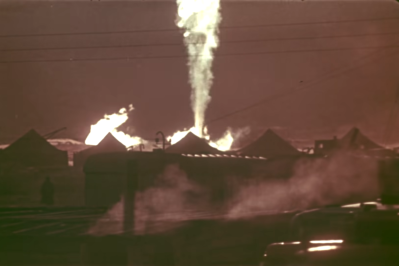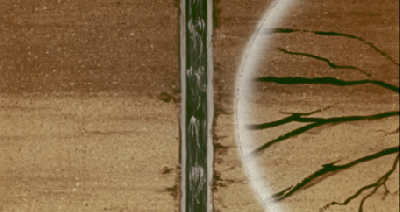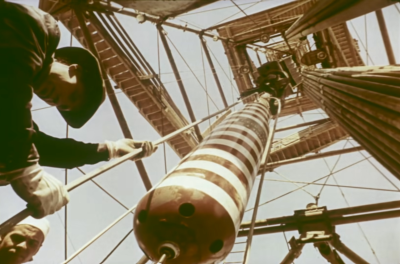Nuclear explosives were first developed as weapons of war in the pitched environment of World War II. However, after the war had passed, thoughts turned to alternative uses for this new powerful technology. Scientists and engineers alike dreamed up wild schemes to dig new canals or blast humans into space with the mighty power of the atom.
Few of these ever came to pass, with radiological concerns being the most common reason why. However, the Soviet Union did in fact manage to put nuclear explosions to good use for civilian ends. One of the first examples was using a nuke to plug an out-of-control gas well in the mid 1960s.
The Conventional Method Attempted

On December 1, 1963, Well No. 11 in the Urta-Bulak gas field suffered a blowout due to a violation of proper drilling procedures. The 2409 meter deep hole opened up a gas reservoir underground with pressure of 300 atm. The blowout caused significant destruction in its wake, and the gas quickly caught fire at the surface, stretching 120 meters into the sky. Tractors were used to clear the site, but the flame continued burning 12 million cubic meters of gas every day.
The situation was a difficult one from the outset. Initial attempts used water to cool the area and reduce the size of the flame so that diverters could be installed to redirect the gas and burn it off safely.
Well No. 11 wasn’t giving up without a fight however, and the pressure restriction introduced by the new diverter cap simply led to the gas permeating other subsurface layers around the original borehole. The gas had a high hydrogen sulfide content, and craters began forming at the surface with the poisonous gas bubbling up from underground. This situation was far too dangerous to continue, so the diverter was removed shortly after.
Two more years were spent trying to stem the flow of gas with traditional methods. Multiple relief wells were drilled in an attempt to pump fluid into the gas formation to stem the flow. However, the problem was that the original Well no. 11 had been drilled well off-vertical, being up to 120 meters off-target at the 2400-2600m depth. Thus, drilling a relief bore was difficult as crews didn’t know exactly where they really should be drilling to gain access to the reservoir.
Screw It, Time For Nukes
https://www.youtube.com/watch?v=2KJ6p4JVN4g
The summer of 1966 saw a new plan come to fruition, spawning a film which followed the experiment along the way. The Soviet government had recently established a program to explore the use of nuclear explosions for peaceful ends, by the name of Nuclear Explosions for the National Economy. The aim was to explore a wide variety of ways in which powerful nuclear explosives could help achieve peaceful goals in industry and other fields.

With the new program up and running, the leaders were approached as to whether a nuclear explosion might be put to the task of closing the recalcitrant Well No. 11 at the Urta-Bulak gas fields. The hope was that a nuclear explosion underground, next to the well, could squeeze the hole closed. The plan called for a 30 kiloton nuclear device to be detonated within approximately 25-50 meters of the original well hole. Geological analysis suggested that the well should be pinched off approximately 1500 meters underground. This depth featured sandstone sediments beneath a thick layer of clay above, with the clay considered likely to be non-permeable enough to seal off the well.
To achieve the task, the well’s actual path had to be determined, and it was eventually found to be 50-60 meters to the northeast of its intended vertical path at the 1500 meter depth. With the location of the well now known, a killing well was carefully drilled that would allow the nuclear device to be placed in an appropriately close position.
Huge amounts of equipment were brought on site to handle the task. Radiological and seismic monitors were all on hand for the first-of-its-kind experiment. A command station was established on site to allow the nuclear device to be detonated, specially built for the purpose by the Arzamas nuclear weapons laboratory. The nuclear explosive was carefully lowered into place, and the killing well was then cemented in order to avoid leaving a secondary path for gas to leak to other geological strata underground.

The device was detonated on the morning of September 30, 1966, by which point the well had been leaking gas for a full 2 years and 9 months. A 5 km blast radius was cleared for safety, with all personnel and vehicles removed from this area. The explosion was surprisingly undramatic, with a slight shift seen in the ground and a rumble heard and felt, but little more than that. The gas flare immmediately began to shrink, and extinguished just 23 seconds after detonation.
Radiological safety planes flew over ground zero shortly after, reporting no major radiation above background and no traces of methane. Radiation at ground level was also detected to be within usual limits. Overall, the experiment had worked, quickly bringing to an end what had been a thus far intractable problem. From there, it was a simple job of sealing up the upper section of the well and putting to rest what had been a long and difficult chapter in the Urta-Bulak gas fields.
Four More Times
Sealing off the well saved billions of cubic meters of gas from being wasted, and the experiment was seen as a great success. As explored in a wide-ranging US government report from 1996, the Soviets went on to use the same concept a total of four more times. Wells at the Pamuk, Mayskii, and Krestishche gas fields were each successfully sealed off with nuclear devices from 1968 to 1972. The last attempt was made in 1981, at a well in the Kumzhinsky gas deposit on Russia’s northern coast. Details are scarce, but the explosion failed to seal the well, potentially due to poor information on the location of the target to be sealed.
Since then, the concept of using nuclear explosions for peaceful ends has largely fallen out of favor. Concerns about radiological contamination, nuclear proliferation, and the potential theft and misdirection of nuclear devices have all been cited as reasons against such use. The Soviet program itself ended after moratoriums on nuclear testing came in to being in the late 80s and early 90s. However, as the Soviets demonstrated ably in the mid-20th century, a nuclear explosion could seal a blown out gas well. On those merits and those merits alone, it did the job!















Great story!
Fully agree! Had never heard of this before. Well done, Hackaday!
The flip-side of this is nuclear explosions to “stimulate” gas fields. Done by Project Plowshare here in the US: https://en.wikipedia.org/wiki/Project_Plowshare#Natural_gas_stimulation_experiment
Natural gas stimulation experiment
Three nuclear explosion experiments were intended to stimulate the flow of natural gas from “tight” formation gas fields. Industrial participants included El Paso Natural Gas Company for the Gasbuggy test; CER Geonuclear Corporation and Austral Oil Company for the Rulison test;[15] and CER Geonuclear Corporation for the Rio Blanco test.
The final PNE blast took place on May 17, 1973, under Fawn Creek, 76.4 km north of Grand Junction, Colorado. Three 30-kiloton detonations took place simultaneously at depths of 1,758, 1,875, and 2,015 meters. If it had been successful, plans called for the use of hundreds of specialized nuclear explosives in the western Rockies gas fields. The previous two tests had indicated that the produced natural gas would be too radioactive for safe use; the Rio Blanco test found that the three blast cavities had not connected as hoped, and the resulting gas still contained unacceptable levels of radionuclides.[16]
Fracking wells with frickin’ nukes!
Fallout vehicles powered by radioactive gas.
That’s very cool. Kudos to the soviets for using nuclear explosions for the national economy.
I’m also horrified by the amount of gas that must have been wasted before they thought of this. 12bcm? I know its small in global scales, but still a lot.
Just remember, for decades, the Saudis burned off enough natural gas _each_ _day_ to supply the natural gas needs of the British Isles for _thirty_ _years_!
Can she travel back in time 30-40 years?
They finally figured out they could use the gas to make more money (such as fertilizer).
All these annoying kids that seem to know better than the rest of us. Just tell them this xmas there will be no mobile phone, no xbox and all their toys will be made from wood.
If they still dont get it, remove the TV, internet, chocolate and foreign holidays.
If they really dont know when to shut up, make them walk to school in the rain wearing animal hide and cloggs.
*up hill both ways
Nuclear explosives would be so useful in peaceful applications if it wasn’t for that pesky radiation. Where would we be if every time we exploded ANFO or TNT it released a huge cloud of phosgene gas.
I think they would have got more use if it hadn’t been for the extraterrestrials banning them. According to them, nukes set off here have non local quantum effects that cause natural disasters on other habitable planets.
What do you exactly mean with that Bob??
I do wonder how much of that video is propaganda and how much is true. There are some things like obviously overstated like @17:15 where the Russian narration is “Radiation? Nyet! (No!)” and the closed caption translation (which of course isn’t original, but still…) is “radiation levels are within natural background limits”. I’m also not sure I buy the gurgling mud (17:33-18:00) being explained as steam from rocks that had been heated by the fire rather than methane leaks of some sort, though I guess it’s possible. Alternatively, I guess it is possible that there could be some small shallow reservoir of methane that is still emptying itself but no longer being resupplied from the primary reservoir. I did come across some OSTI (a records department of the US DOE) documents that discuss the operation as being successful. https://www.osti.gov/servlets/purl/4353229
Thanks. The OSTI document was very interesting.
Some of those holes just west of Area 51 were part of the US efforts in this direction via Operation Plowshare. I believe the largest one, Sedan Crater was one of the attempts to see how much soil could be displaced with “thermonuclear mining”.
nuke all the things!
I recently was looking into the above link for data regarding exposure to possible nuclear waste and/or radiation at the Uzbekistan K2 airbase. I couldn’t find any info on the location of Pamuk when I did a quick online search. Only found info on the above noted better propagandized Urtabulak test site. Was wondering if anything was ever shipped from either of or any of the other sites to the K2 region.
Here are two interesting links for reading into more that go along great, I thought, with the above OSTI document:
https://en.wikipedia.org/wiki/Nuclear_Explosions_for_the_National_Economy
https://en.wikipedia.org/wiki/Peaceful_nuclear_explosion
I was under the impression speaking to an oil and gas exec in Houston on a trip, that the Soviets had utilized the underground spheres for storing oil and/or gas and had determined a way to process the stored minerals for later use. Where at first, the material was to highly radioactive to consider distributing and using. Anyone have any resources or ideas?
I’ve since lost the gentleman’s business card and don’t remember much other than him affirming a thought I had regarding somewhere prior learning about the glass lined underground weapons testing caverns left after the detonation and subsequent events. Never did follow up since I’ve been shy to work for the petrochemical industry. Good pay, great health insurance… though risky almost certain adverse effects in certain roles.
The remote sensing and other exploration related roles don’t seem so bad, other than in hostile environments where you need a militia with you at all times.
Oh why should we listen to them, what have they ever given us? Velcro! Pppppth!
Nuclear devices are designed to kill as many people as quickly as possible. Using them in any other application is a hack. Sealing off gas leak certainly counts, as a hack.
Nuclear devices are designed *destroy things*, people being in the way is an unfortunate side effect.
Chemical and biological weapons are designed to kill.
“unfortunate side effect” is the finest sarcasm I’ve heard for an long time ;-) At least I hope so.
https://en.wikipedia.org/wiki/Neutron_bomb
Makes me think of the almanac in “Dr. Strangelove”: “World Targets in Megadeaths” …
Maybe something like this could have helped with the Deepwater Horizon mess.
I think they should have tried some bigger conventional explosives before jumping to nukes, but I’m sure they were happy to finally have a nail for their rocket sledge.
The borehole is narrow, you simply can’t put that much conventional boom into it. Also – if the conventional explosion fails to seal the well, you’ve just created more damage and it will be even harder to try again.
Considering the time, resources, effort, and risk that went into drilling the kill well I sure would have wanted to use the most effective explosive for the job which is nuclear. You have a limit on the size of the kill well. The question is why NOT use the nuke as long as above ground radiation effects are under control. Consider that if your conventional explosive fails, you have lost the kill well and possible made another blowout.
Yet another way that nuclear power can reduce fossil fuel pollution.
Nice thought!
“Radiation at ground level was also detected to be within usual limits” – that’s what they said about Tchernobyl, before the truth was no longer to hide.
Please don’t forget: this was the Sowjet Union, in the middle of the cold war – and the peak of the propaganda war.
The wiring nightmares and the equipment on wobbly tables. Is precision Soviet engineering!